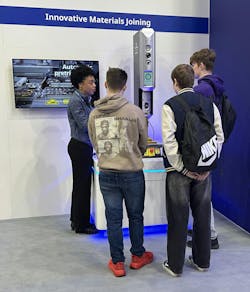Fastening & Joining: Emerson Ultrasonic Welder Is an Automation-Ready Asset
The Branson Polaris IW Ultrasonic Welder was one of the displays Emerson brought to Hannover Messe earlier this year. This is where Kerryn Harrington, an ultrasonics product manager at Emerson’s Branson division, demonstrated just how user-friendly the entry-level, all-in-one design system can be.
“We’ll be launching many Polaris welders this year,” said Harrington. “They come with more features, they are better for automation [and] adaptability, and have more configurable options as well.”
The Branson Polaris Integrated Welder has a 7-in. HMI, LCD touchscreen that features an operation summary display. Users can view recipe parameters, calibrations, weld history and alarm log as well as system information and diagnostics. Other features include a load cell for precise trigger setting, horn diagnostics, built-in amplitude control, pre-trigger function and cycle and batch counter. The welder has enhanced cybersecurity to keep manufacturing assets safe and compliant, according to Emerson’s press note.
Joining a Plastic Part
For the demo, Harrington set up the welder by selecting a recipe from the touchscreen. It can be customized for each application, she said, and users can “have a custom horn and tooling as well.” The part in Harrington’s demo resembled a plastic cover designed for an electronic device.
“I’m bonding a plastic part,” said Harrington. “This is something that we use for early applications testing. I’m placing it [on the base] and all we have to do is press these two buttons on the side, and that's it. Now we went from two parts to one part. You can see it’s very strong. You cannot break it, even if you tried.”
The new line of integrated welders was developed to streamline welding and bring efficiency and scaling capabilities to the plant floor. “Ultrasonic welding is a way to replace traditional material joining methods like glue, screws, adhesion,” explained Harrington.
Ultrasonic welding is a solid-state joining method that applies high-frequency vibrations under moderate pressure to bond materials such as thermoplastics and metals. Frictional heat is delivered to the interface, which disrupts the materials structure just enough to weld the pieces. There are no connective adhesives or soldering materials. To ensure a strong bond, key parameters—including amplitude, pressure, weld time and frequency—must be tightly controlled. The process is highly repeatable, and suitable for precision applications.
“This is a method that’s much more energy saving, better for sustainability,” said Harrington. “And there are no consumables, so you’re not having to buy additional glue or fasteners. There’s no dry time; it happens within seconds.”
The scope of applications includes automotive, textile, consumer electronics and food packaging.
Emerson said upcoming Polaris product releases will be enhanced to meet the need for scalable, automation-compatible systems. The updates would cover configurable controls, power supplies and software. Better connectivity will enable operators to analyze data, boost performance and maintain compliance in changing operating conditions, the company noted.
Engineered for Success: Kerryn Harrington, Global Product Manager, Emerson
Step inside the real stories of engineers as they share candid snapshots of their career journeys, challenges and triumphs. This dynamic series builds on Machine Design’s commitment to spotlight the issues shaping today’s engineering workplace—covering everything from leadership strategies and management insights to in-depth profiles of innovators across every engineering discipline. We also highlight voices from equity-seeking groups, ensuring a diverse and inspiring perspective on what it means to thrive in engineering today.
Visit Machine Design’s WISE (Workers in Science and Engineering) hub to explore more topics, expert advice and meet inspiring people in this series.
One to Watch: Kerryn Harrington
Job Title: Global Product Manager
Company: Emerson
In Her Own Words:
Hello Everyone, I have a background in biomedical engineering.
I studied at the Rensselaer Polytechnic Institute, which is an engineering school in upstate New York.
When I was studying and working there, I did internships in pharmaceuticals, personal care products, so it was more biotechcentric.
But when I graduated, I knew I wanted to have more broad experience and different industry experience. Emerson was a company that allowed me to not solidify my career just yet. I wanted to really explore more and have the opportunity to travel and go to a global company.
The Emerson Engineers in Leadership Rotational Program is a two-year rotational program. It’s really targeted at engineering, new grads that want broader experience, that want to be leaders one day, want to be executives in a company. With this program, I was able to do two different rotations at two different locations.
Usually, you go abroad for a year. I was going to live in Singapore, but I graduated during COVID, so that didn’t happen. I spent one year in Ohio, at our Commercial & Residential Solutions Business and then one year in Florham Park, N.J. at our Discrete Automation business.
I now work at Branson as a product manager. I’ve been here for about three years. In this role, I’ve been able to launch new products, which has been really exciting.
It’s a lot of hard work and a lot of challenges, but through this I’ve really grown in my career and I’m thankful that I’m giving these opportunities.
Editor’s Note: Machine Design’s WISE (Workers in Science and Engineering) hub compiles our coverage of workplace issues affecting the engineering field, in addition to contributions from equity seeking groups and subject matter experts within various subdisciplines.
About the Author

Rehana Begg
Editor-in-Chief, Machine Design
As Machine Design’s content lead, Rehana Begg is tasked with elevating the voice of the design and multi-disciplinary engineer in the face of digital transformation and engineering innovation. Begg has more than 24 years of editorial experience and has spent the past decade in the trenches of industrial manufacturing, focusing on new technologies, manufacturing innovation and business. Her B2B career has taken her from corporate boardrooms to plant floors and underground mining stopes, covering everything from automation & IIoT, robotics, mechanical design and additive manufacturing to plant operations, maintenance, reliability and continuous improvement. Begg holds an MBA, a Master of Journalism degree, and a BA (Hons.) in Political Science. She is committed to lifelong learning and feeds her passion for innovation in publishing, transparent science and clear communication by attending relevant conferences and seminars/workshops.
Follow Rehana Begg via the following social media handles:
X: @rehanabegg
LinkedIn: @rehanabegg and @MachineDesign


